
SgtLongcoat
-
Posts
68 -
Joined
-
Last visited
Content Type
Profiles
Forums
Downloads
Blogs
Events
Store
Posts posted by SgtLongcoat
-
-
Charon Refueler Pre-Flight
Available Funds: $376,539
Vehicle Parts List:
- 1 Clamp-O-Tron Shielded Docking Port ($400)
- 1 FL-T200 Fuel Tank ($275)
- 1 FL-T400 Fuel Tank ($500)
- 1 FL-T800 Fuel Tank ($800)
- 1 Z-1k Rechargeable Battery Bank ($880)
- 1 RC-001S Remote Guidance Unit ($2250)
- 1 Advanced Inline Stabilizer ($1200)
- 1 TR-18A Stack Decoupler ($400)
- 1 C7 Brand Adapter - 2.5 m to 1.25 m ($800)
- 1 Rockomax Jumbo 64 Fuel Tank ($5750)
- 1 RE-15 "Skipper" Liquid Fuel Engine ($5300)
- 4 TT-38K Radial Decoupler ($600)
- 4 BACC "Thumper" Solid Fuel Booster ($850)
- 4 Aerodynamic Nose Cone ($240)
- 4 Standard Canard ($720)
- 4 EAS-4 Strut Connector ($42)
- 4 RV-105 RCS Thruster Block ($620)
- 2 Stratus-V Roundified Monopropellant Tank ($200)
- 2 OX-4W 3x2 Photovoltaic Panels ($380)
Design Goals: The Charon Refueler Rocket is designed with the sole purpose of providing the precise amount fuel needed to refuel the Kerbinational Space Station. With four solid fuel booster meant for exiting the atmosphere, and one orange liquid fuel tank, our hope is that this will allow the Charon to dock with and refuel the KSS.
Launch Goals: Our goal is for the Charon Refueler will be able to both dock with and fully refuel the Kerbinational Space Station, providing approximately $1,000,000 in funds. With these funds, we aim to design a rocket that can land on either the mun or minmus and safely return.
Pilot Plan: Use the solid rocket boosters to gain altitude, and then jettison them once empty. Stage 2 will be used for circularization as well as the rendezvous with the KSS. Once it's out of fuel, it will be jettisoned and the RCS will be used to maneuver for docking.
-
Kerbinational Space Station Post-Flight
Launch Time: 10:37 AM, May 31, 2017
Team Present: Kenny Sorlie, Sam Papaleo, Jon Mura
Flight Log:
- t+ 0 launch at half throtle
- t+ 50 Begun to rotate east to 80o
- t+ 2:05 Jettisoned 3 outer liquid rockets, cut throttle
- t+ 3:53 Begun burning prograde near apoapsis until in orbit
- t+ 4:38 Cut thrust, now in orbit
- t+ 5:31 Opened Solar Panels and Communatron
- t+ 13:30 Burned Pro-grade at the apoapsis until the periapsis reached ~137 km. Apoapsis is at ~139
- t+ 14:20 Transferred liquid fuel and oxidizer into the storage tank. Unfortunately not enough to fill it up.
- t+ 14:40 Jettisoned rocket
- t+ 1:13:05 Maneuvered space station for easy docking
Summary: For getting our manned space station into orbit, our plan was an overall success. There were no major problems during this launch (surprisingly), and we expect the space station to remain stable permanently. Our only regret is that there wasn't enough fuel leftover in the rocket to fully fuel our refueling station half of the station.
Project Timeline: Our next flight remains as an attempted docking with our space station, with the notable exception that, instead of already being fueled, we will be attempting to refuel our space station during the launch.
Milestones Presented: First manned space station in orbit - $130,000
Available Funds: $366,244 - $108,823 - $10,882 (tax) + $130,000 (Space Station) = $376,539
-
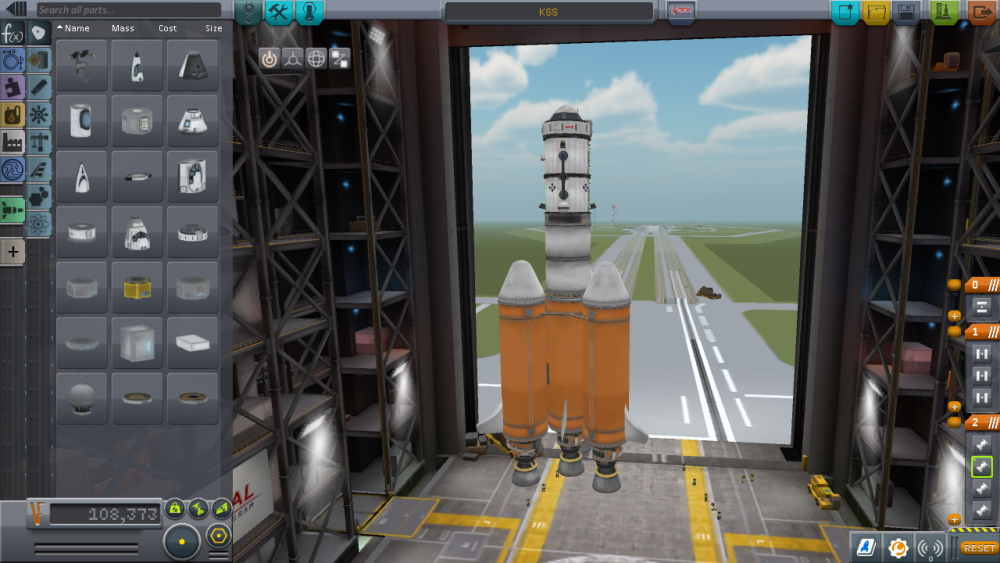 Kerbinational Space Station Pre-Flight:
Kerbinational Space Station Pre-Flight:
Available Funds: $366,244
Vehicle Parts List:
- 4 Rockomax Jumbo-64 Fuel Tank ($5750)
- 1 Rockomax X200-32 Fuel Tank minus fuel ($1531)
- 3 Nose Cone Mk7 ($450)
- 2 PPD-10 Hitchhiker Storage Container ($4000)
- 1 PPD-12 Cupola Module ($3200)
- 4 RE-M3 "Mainsail" Liquid Fuel Rockets ($13000)
- 3 AV-R8 Winglet ($640)
- 3 AV-T1 Winglet ($500)
- 3 TT-38K Radial Decoupler ($600)
- 6 EAS-4 Strut Connectors ($42)
- 1 Clamp-O-Tron docking Port Sr. ($980)
- 1 Clamp-O-Tron Shielded Docking Port ($400)
- 1 Advanced Reaction Wheel Module, Large ($2100)
- 4 RV-105 RCS ($620)
- 2 Illuminator Mk2 ($100)
- 2 Stratus-V Roundified Monoprop Tank ($200)
- 2 Gigantor XL Solar Array ($3000)
- 1 Communotron 88-88 ($1100)
- 2 Z-100 Rechargeable Battery Pack ($80)
- 3 FTX-2 External Fuel Duct ($150)
Design Goals: The KSS is designed to be a combination manned space station and small scale refueling station, with the capacity to be extended with additional parts. With the KSS, kerbal-kind will finally be able to live in space for an indefinite amount of time. (Note: Remind our engineers that food is still required in space, especially if our astronauts are meant to stay up there)
Launch Goals: For this launch, we are planning to get a manned space station/refueling station into low kerbin orbit, and have the ability to dock with it at a later time. Our next flight will consist of us sending up a second fuel tank to dock with our space station and expand our refueling capacity.
Milestone Goals:
- First manned space station in orbit - $130,000
- First fully-fueled orbital refueling station around Kerbin - $500,000
Pilot Plan: Use stage 1 until radial tanks are empty, then use stage 2 for high altitude maneuvers and finalizing the orbit placing the space station in a equatorial orbit of around 120km. Once the station is in the desired orbit, jettison stage 2 along with the engine after transferring any remaining fuel to the onboard tank.
-
"Hyperion" Satellite Post-Flight
Launch Time: 11:11 AM, 5/18/17
Team Present: Jonathan Mura, Kenny Sorlie (Sam Papaleo present for start of launch)
Flight Log:
- t=4 - First stage thrusters at max
- t=21 - Turned off liquid thruster
- t=1:07 - Ejected solid boosters and aimed towards the east
- t=1:20 - Full liquid thrusters
- t=1:51 - Turned off liquid thrusters
- t=2:45 - Full thrusters at 15o above the horizontal
- t=3:10 - Levelled to 0o prograde
- t=3:41 - Cut thrusters until apoapsis reached
- t=4:19 - Full thrusters at apoapsis
- t=4:37 - cut thrusters - low orbit achieved
- t=32:13 - Maneuvered to burn prograde at periapsis (Begin Hohmann Transfer)
- t=33:06 - Full thrust at periapsis
- t=33:45 - Released empty fuel, full thrust with small liquid thruster
- t=34:40 - Maneuvereed to retrograde to decrease apoapsis
- t=35:47 Released capsule surrounding satellite. Satellite still attached to rocket. Extended instruments
- t=1:55:30 Maneuvered to burn prograde
- t=1:57:06 Full thrust at apoapsis
- t=1:57:30 Cut thrusters
- t=2:29:06 Burned fuel full thrust for ~.5s at periapsis. Apoapsis overshoots by several thousand meters
- t=2:29:24 Burned retrograde for ~3s
- t=4:51:40 Burned retrograde at the apoapsis until the periapsis reached 2,866 km
- t=1d 1:51:22 Burned retrograde at periapsis until apoapsis reached 2,866 km
- t=1d 2:50:46 Used RCS thrusters at apoapsis to reduce periapsis to 2,863 km
- t=1d 5:48:23 Used RCS thrusters at periapsis to reduce apoapsis to 2,863 km. Keosynchronous orbit achieved
Photographs:
Total Flight Time: Still in orbit
Summary: Overall, a successful mission. While our expert pilot did make a few mistakes that extended our total flight time by a few in-game hours, the flight went off without a hitch. There were no explosions, everything operated smoothly, and there's still enough fuel on the Hyperion to make adjustments should the need arise. We achieved two milestones on this launch: First working satellite placed in stable orbit - $80,000, and First working satellite placed in geosynchronous orbit - $100,000.
Learnings: It is relatively simple, and not very costly to get an object into orbit. It should be extremely simple to force an object into orbit in such a way that we make quick contact with the mun.
Strategies: Our next goal is to either put up a manned space station, or to get a kerbal to the mun. If we put up the space station first, that could create a very simple stopping point mid-flight to refuel and store crew to prevent excessive death in case of catastrophe.
Milestone Awards Presented: First working satellite placed in orbit - $80,000; First working satellite placed in geosynchronous orbit - $100,000.
Final Funds: $256,182 (Starting Funds) - $63,580 (Rocket) - $6,358 (Tax) + $80,000 (First Satellite in Orbit) + $100,000 (First Satellite in Geosynchronous Orbit) = $366,244
-
"Hyperion" Satellite Pre-Flight
Available Funds: $256,182
Vehicle Name: Hyperion
Vehicle Parts List:
- 2 Rockomax Jumbo-64 Fuel Tank ($5750)
- 1 Rockomax X-200-16 Fuel Tank ($1550)
- 2 S1-SRB-KD25K "Kickback" Booster ($2700)
- 1 RE-M3 "Mainsail" Liquid Fuel Engine ($13000)
- 1 RE-I5 "Skipper" Liquid Fuel Engine ($5300)
- 8 RV-105 RCS Thruster Block ($620)
- 2 Stratus-V Roundified Monopropellant Tank ($200)
- 1 FL-R25 RCS Fuel Tank ($600)
- 1 RC-001S Remote Guidance Unit ($2250)
- 1 Z-1k Rechargeable Battery Bank ($880)
- 2 Gigantor XL Solar Array ($3000)
- 1 Communatron 88-88 ($1100)
- 1 TR-18A Stack Decoupler ($400)
- 1 AE-FF2 Airstream Protective Shell (2.5m) ($854)
- 1 Rockomax Brand Decoupler ($550)
- 1 Advance Reaction Wheel Module Large ($2100)
- 2 Advanced Nose Cone - Type B ($320)
- 4 AV-R8 Winglet ($640)
- 4 AV-T1 Winglet ($500)
- 8 EAS-4 Strut connector ($42)
- 2 TT-38K Radial Decoupler ($600)
(Some cost in image due to change in shape of capsule holding satellite)
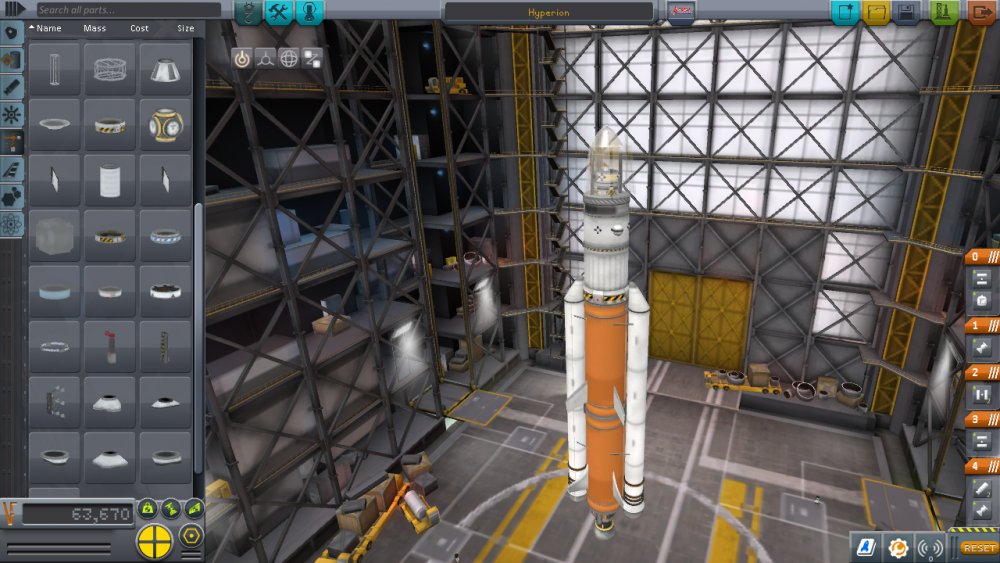
Design Goals: Rocket designed to exit atmosphere and enter Low-Kerbin Orbit. The second stage will then be used to conduct a Hohmann Transfer to enter Keosynchronous orbit, and remaining fuel used to fine tune Periapsis and Apoapsis. In a real-life scenario, would function as a comm. satellite.
Launch Goals: Our hope for this launch is to get our satellite into geosynchronous orbit with kerbin, accomplishing the first two satellite milestones. After this, our next goal will either be to setup a space station, or reach the mun.
Pilot Plan: Use the solid fuel thrusters and large liquid thruster to exit atmosphere. Detach solids once fuel runs out. Use large liquid thruster to get rocket into eastward low-kerbin orbit (70,000+ m), and use remaining fuel to extend the orbit further out. Detach large liquid fuel thruster, switching to the small liquid fuel thruster. Using small liquid fuel thruster, conduct a Hohmann Transfer by burning prograde at the periapsis until apoapsis is at ~2,863,333 m, then cut thrusters and wait until rocket hits apoapsis. At apoapsis, burn prograde until periapsis is at ~2,863,333 m. Use liquid fuel & manually controlled RCS thrusters (detach liquid fuel once out) to fine tune orbit. Solar panels and antenna set to extend with light key.
-
Team Name: MuraLeo Inc.
Available Funds: $70,549
Vehicle Name: The Traveller Mk 3
Vehicle Parts List: 1 Mk. 1 Command Pod $600, 1 FL-T400 Fuel tank $500, 4 FL-T800 Fuel tank $800, 3 TR-18A Stack Decoupler $400, 3 RV-105 RCS Thruster Block $620, 1 Mk.16 parachute $422, 5 RT-10 "Hammer" Booster $400, 3 Mk-12R Radial Mount Drogue Chute $150, 1 LV-909 "Terrier" Liquid Fuel Engine $390, 3 LV-T45 "Swivel" Liquid Fuel Engine $1200, 1 LV-T30 Liquid "Reliant" Fuel Engine $1100, 7 Aerodynamic Nose Cones $240, 3 AV-R8 Winglet $640, 3 LT-05 Micro Landing Strut $200, 3 TT-18A Launch Stability Enhancer $200, 1 Advanced Inline Stabilizer $1200, 10 Sepratron 1 $75, 1 Z-100 Rechargable Battery Pack $80
Total Vehicle Cost:
Design Goals: The Traveller Mk 3 (Mk 2 not launched due to safety concerns), is designed to exit Kerbin's atmosphere, achieve stable orbit, and return SAFELY to Kerbin's surface
Launch Goals: Achieve following milestones:
- Launch to 10 km
- Manned Launch to 10 km
- Manned Launch to 50 km
- Achieving stable orbit
- Achieving manned stable orbit
- First Kerbal EVA
Pilot Plan: Launch using solid thrusters, then switch to stage 2 to achieve a stable orbit. Using the 3rd stage we will exit orbit and re enter. Through use of main thrusters and other emergency boosters to slow the command pod down, we will land the pod on land.
-
Launch Time: 11:27 AM, May 15, 2017
Members Present: Jonathan Mura, Kenny Sorlie, Sam Papaleo
Flight Log:
- Ground: Activated Solid Fuel Thrusters
- Released Radial Stability Enhancers
- t=0:33, released solid fuel thrusters
- t=0:36, reached 10 km
- t=1:20, turned off liquid thrusters
- t=1:52, rotated to 15o above horizon
- t=2:22, full thrusters
- t=2:41, reached 50 km
- t=5:17, turned to 0o, full throtle
- t=5:19, detached liquid fuel thrusters, entered final stage
- t=5:53, stable orbit, 92 km Periapsis, 94 km Apoapsis
- t=7:00, Valentina EVA
- t=7:40, Valentina returns to ship
- t=23:53, Maneuvered to burn retrograde and reenter atmosphere
- t=24:24, Full thrusters
- t=24:50, Turned off thrusters
- t=28:10, entered atmosphere
- t=28:27, High thrusters to counteract burn up in atmosphere
- t=28:40, Entered surface altitude
- t=29:05, Last of fuel used
- t=29:40, Activated Parachute
- t=29:50, Parachute burned up
- t=29:56, Crash landing, Valentina dead
Memorial: Valentina was a brave kerbal, who wanted nothing more than to go where no other kerbal has gone before. Even in her final moments, the in-flight cameras caught her with a giant grin on her face, knowing that her death would be the base for even greater space operations. While she will be missed, we at Muraleo Inc refuse to let her death put an end to the dreams which Valentina stood for, and will continue to send fearless kerbals where dreams of greatness come true.
Flight Summary: The majority of the flight went off without a hitch. Our biggest concerns stem from reentry into the atmosphere, and ensuring that we have enough fuel to counteract gravity as we decrease altitude. In addition, it may be beneficial to keep the flight in low orbit, so as to reduce the change in velocity during reentry.
Future Strategy: For our next flight, we will be adding more parachutes with a greater speed tolerance, as well as several radially mounted solid fuel thrusters in order to slow down the flight on reentry, assuming it is falling too quickly when the liquid fuel runs out. Our hope is that this will keep our pilot intact long enough for us to treat any injuries accrued over the flight.
Ending Funds: $100,000 (Starting) - $26,774 (Rocket) - $2,677 (Tax) = $70,549 (Final)
"The Traveller Mk 3"
Launch Time: 11:02
Team Present: Jonathan Mura, Kenny Sorlie
Flight Log:
- t=0:00, Stage 1 solid fuel boosters active
- t=0:24, Solids decoupled, Stage 2 liquid fuel at 50%
- t=0:50, 10 km
- t=1:35, Thrusters cut
- t=1:46, Maneuvered to 5o above horizontal
- t=2:00, 50 km
- t=2:48, Full Thrust
- t=3:15, Decoupled Stage 2, Stage 3 liquid at 100%
- t=4:24, Cut thrusters, Stable orbit @ ~80 km
- t=4:47, Bill EVA
- t=4:54, Bill reenters vehicle
- t=27:53, Maneuvered to burn retrograde
- t=28:04, Full thrusters to exit orbit
- t=28:35, Cut thrusters to conserve fuel
- t=31:00, Entered atmosphere
- t=31:35, Full thrusters to prevent overheat on reentry
- t=31:53, Jettisoned Stage 3
- t=32:18, Activated first set of emergency solid thrusters
- t=32:26, Drogue chutes deployed
- t=34:46, Deployed main parachute
- t=35:00, Deployed second set of emergency thrusters & crash landed. Bill survived
Photographs:Total Flight Time: 35:00Summary: Launch and height gain were successful and went without a hitch. Once at a suitable height, we chose 80km, stage 2 was used along with stage 3 to achieve orbit. This orbit was at the same altitude, with a 4km deviation from 80km altitude (82-78). Once over land, the 3rd stage was used to exit orbit back into the atmosphere, where a use of some thrust allowed the ship not to burn up in the atmosphere. Once stage 3 was out of fuel, it was jettisoned and just the pod with it's emergency thrusters and parachutes remained. The pod continued to fall for a while before the first set of "slow down" thrusters were activated, slowing the pod down to a speed where drouge chutes could be used. These slowed the pod down to 25 m/s until very close to the ground, where the main parachute was deployed. The chute was deployed a bit late and wasn't going to open before impact, so the final set of emergency thrusters were used to slow the crash landing. This was successful, and the pod survived the landing, with Bill (somehow) unharmed.Learnings: The emergency thrusters were absolutely a good idea, and used alongside drogue chutes, they can make the absolute safest method of landing a ship after a fast re-entry.Project Timeline: Our next project will likely be to get a small satellite into a stable orbit, as that won't be too difficult and let us learn a bit more about the different parts of the game.Milestone Awards Presented:- Launch to 10 km - $10,000
- Manned launch to 10 km - $20,000
- Manned launch to 50 km - $30,000
- Achieving stable orbit - $40,000
- Achieving stable manned orbit - $50,000
- First Kerbal EVA - $60,000
Available funds: $70,549 (Starting) - $22,152 (Ship) - $2,215 (Tax) = $46,182 (Final)

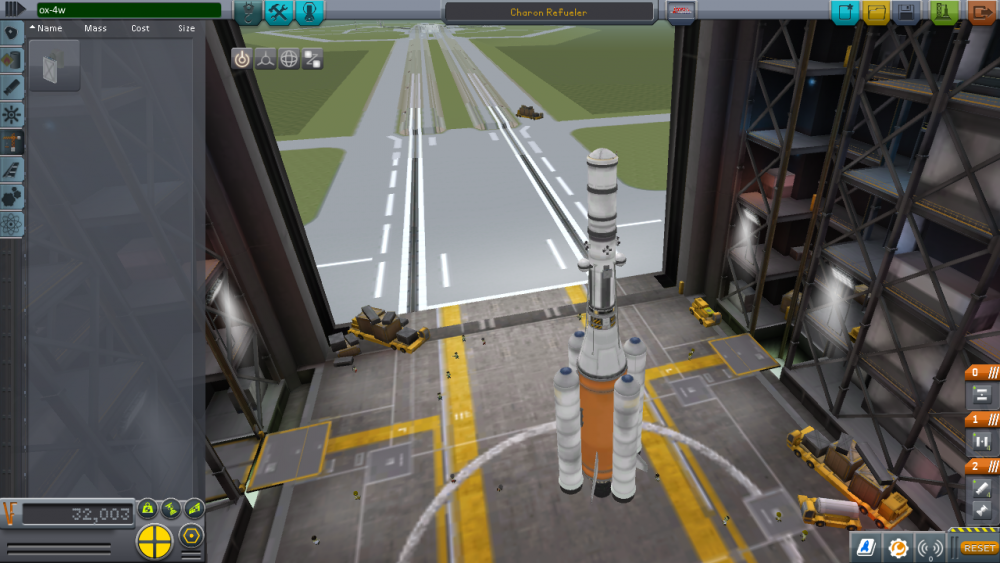
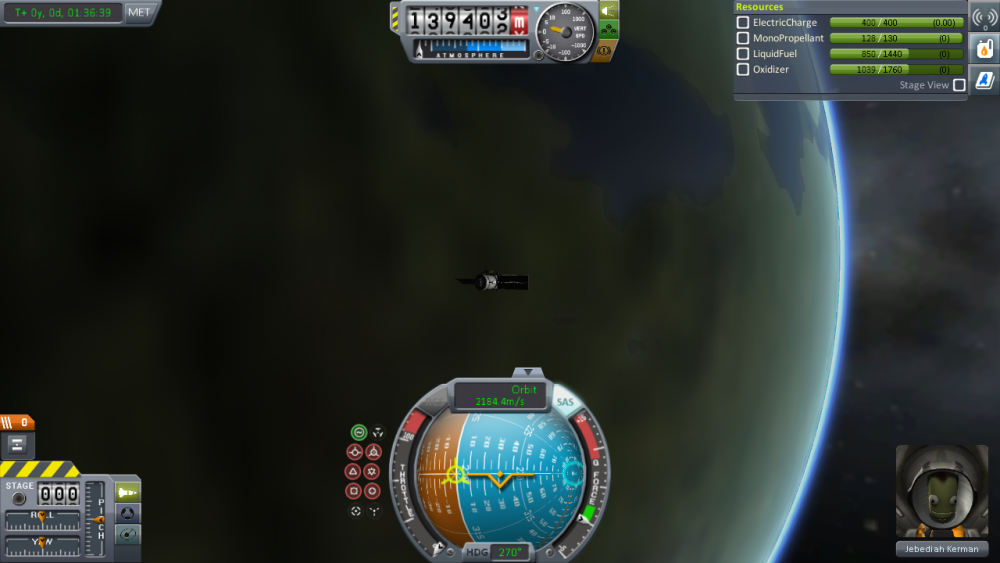

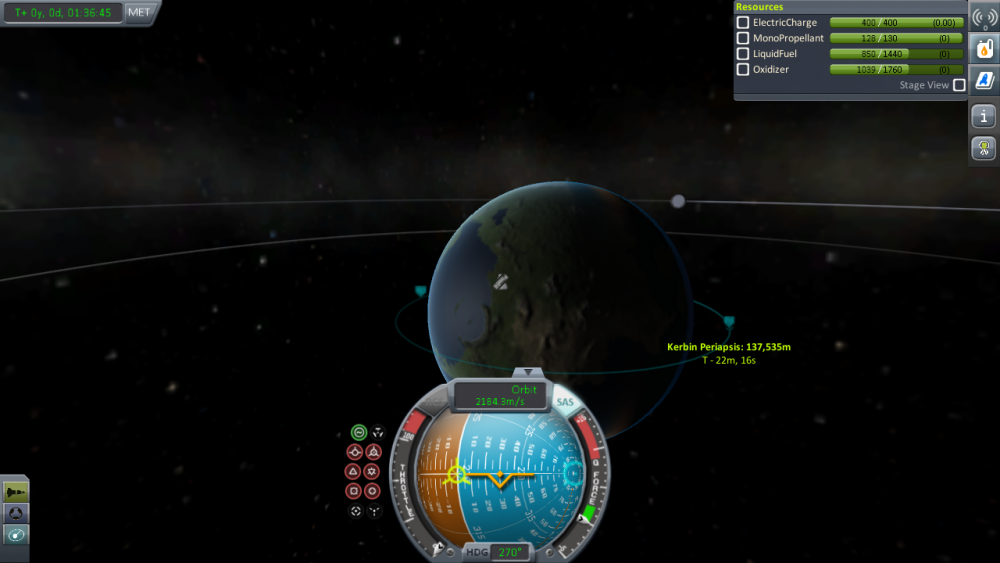

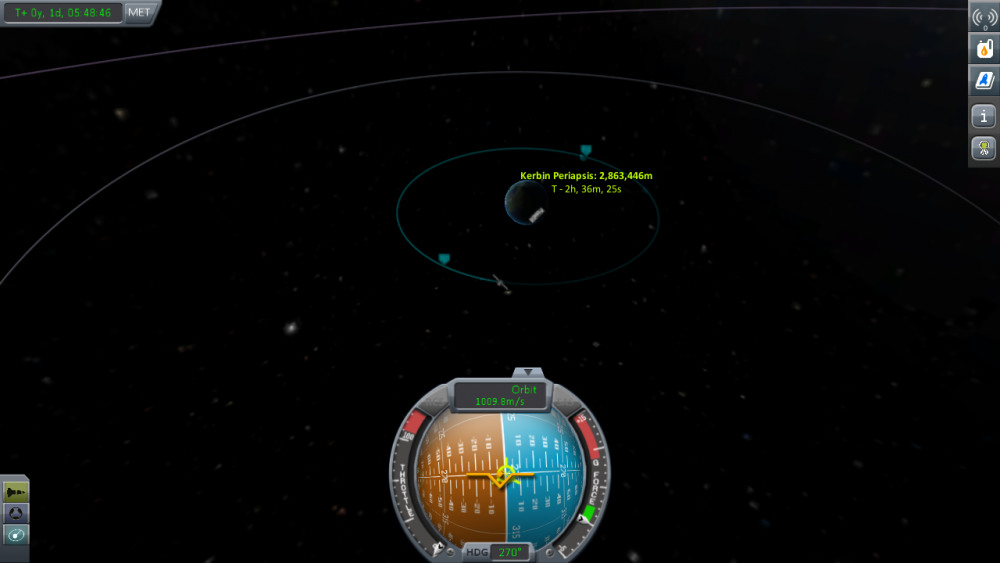
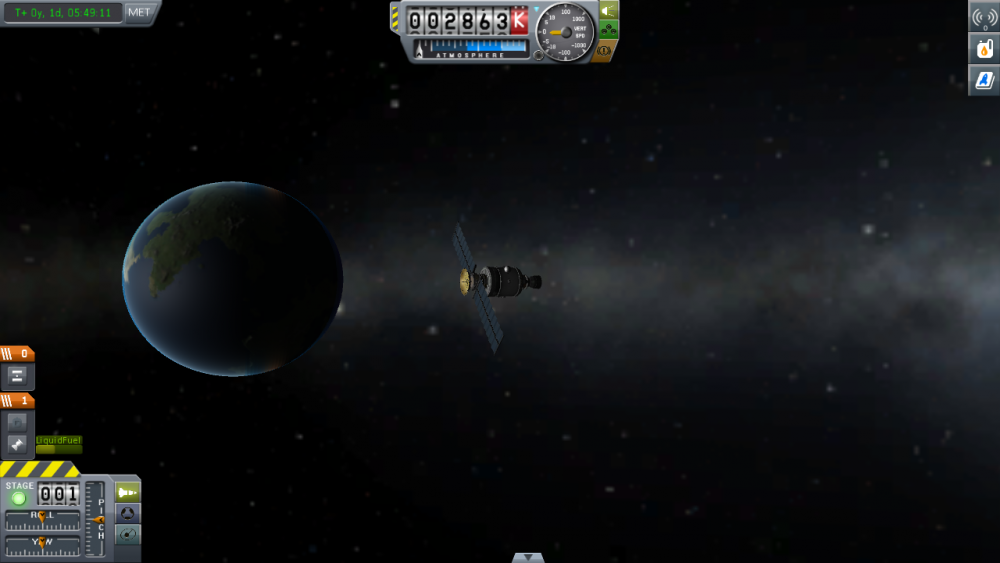
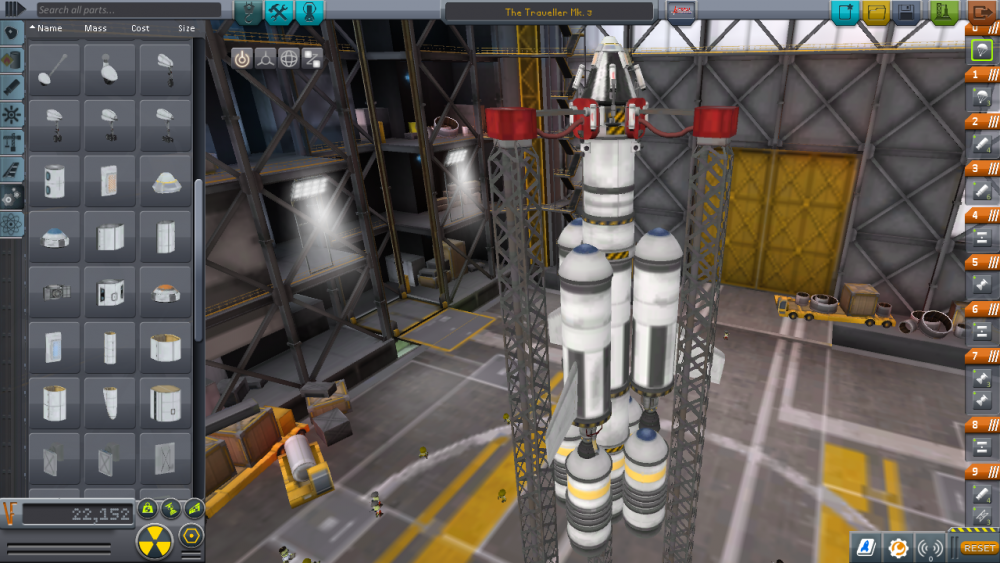

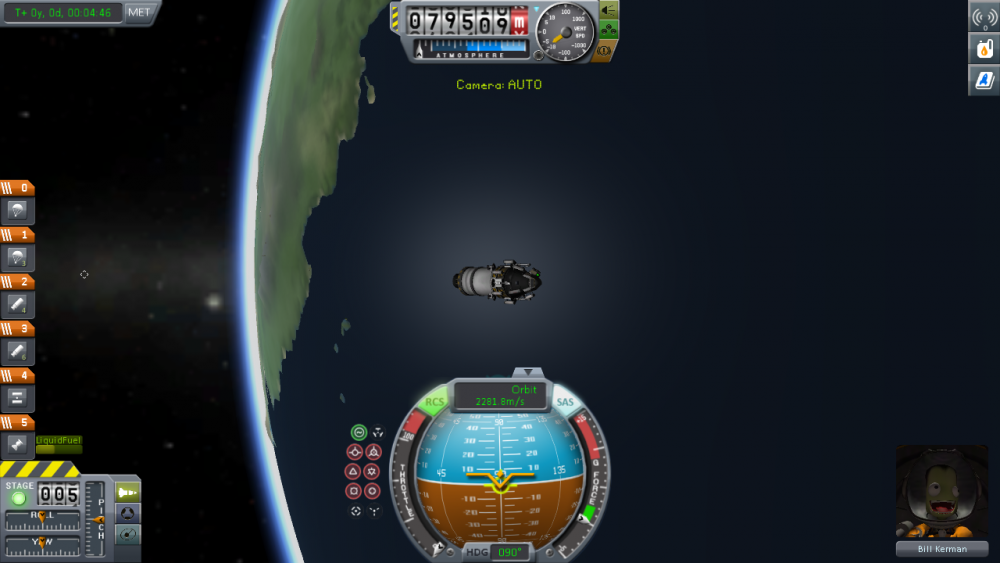
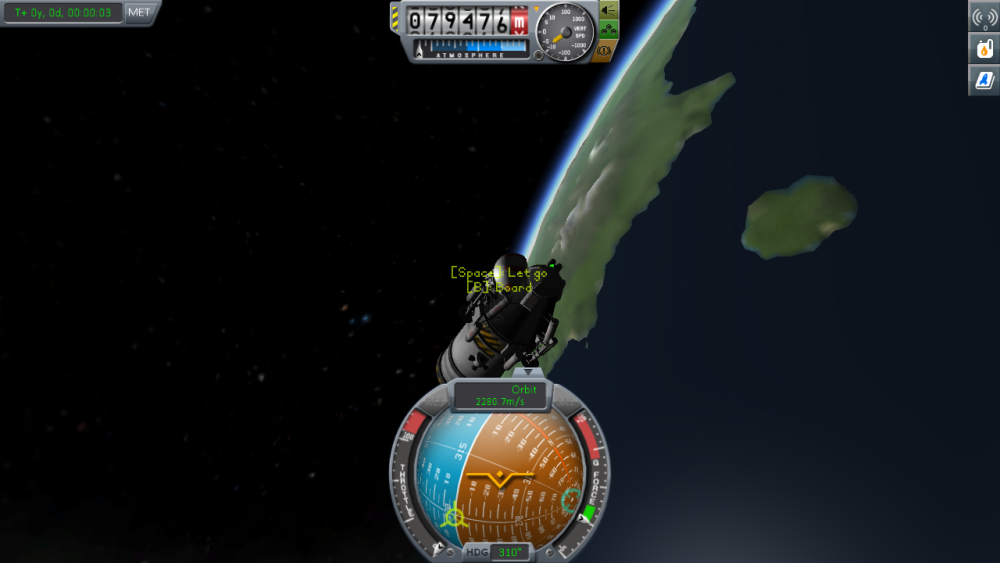
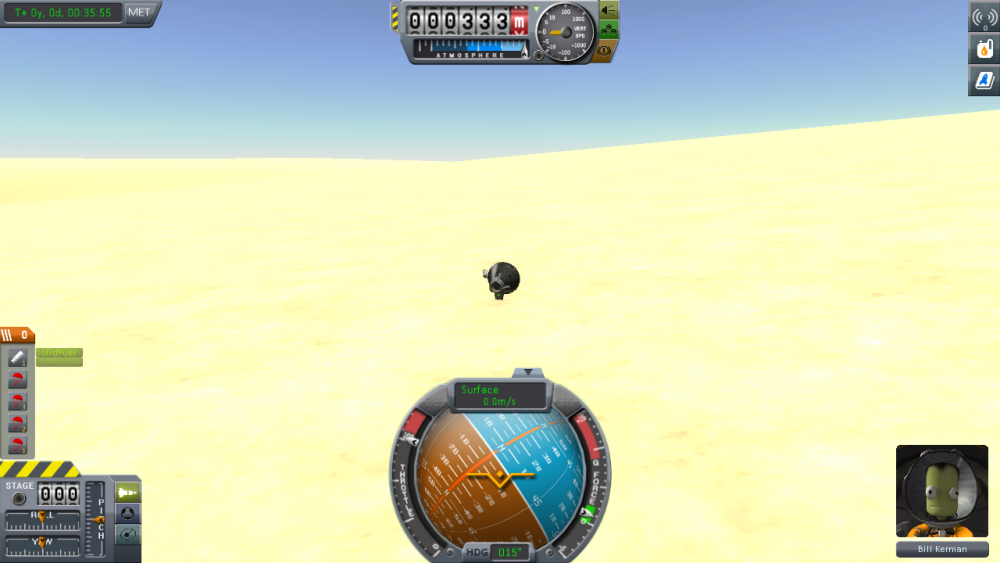
MuraLeo Inc. Launch History
In Labs and Projects
Posted
Duna or Bust Pre-Flight
Available Funds: $376,539
Parts List:
Design Goals: The Duna or Bust Interplanetary Travel Rocket Is perfectly designed for a single Kerbal manned flight to the red planet, Duna. With it's high efficiency atomic "Nerv" engine, the DBITR is able to easily and safely encounter and enter circular orbit of not only Duna, but most planets relatively close to Kerbin. With safety in mind, we've added multiple emergency thrusters and parachutes in order to counteract any high velocity landing path.
Launch Goals: Our major goal for this final launch is to get our pilot, one Bill Kerman, to Duna in order to plant flag eulogizing the Kerbonaut lost by a rival space flight company.
Pilot Plan: We'll first exit Kerbin's atmosphere using the Rockomax tanks and "Mainsail" engine with a west to east cicular orbit. Once out of the atmosphere, we'll circularize the orbit at a low altitude, and begin plotting a maneuver for a Duna encounter. We'll then use our remaining fuel in the Rockomax tanks to escape Kerbin's gravity, and At about this time, we'll likely have to switch from our "Mainsail" to the atomic thruster, which we'll use to fine tune the encounter with Duna and match the inclination. Once on course for a Duna encounter, we'll use the atomic thruster to perform a retrograde capture burn, and perform several Hohmann Transfers in order to enter an orbit in high Duna atmosphere in order to aerobrake. About here, we'll use the remainder of our atomic fuel in order to cut as much of our velocity as possible, and enter the final stage. We'll activate our chutes at around 15,000 m, and use our seperatrons in a latch ditch effort to cut any remaining velocity.